Fabrication of Nanosize ZnO and Zn1−xFexO Powder for Infrared Absorption by Flame Aerosol Synthesis
Abstract
:1. Introduction
2. Materials and Methods
3. Results
4. Discussion
5. Conclusions
Author Contributions
Funding
Conflicts of Interest
References
- Wojnarowicz, J.; Chudoba, T.; Lojkowski, W. A Review of Microwave Synthesis of Zinc Oxide Nanomaterials: Reactants, Process Parameters and Morphologies. Nanomaterials 2020, 10, 1086. [Google Scholar] [CrossRef]
- Sun, X.; Jia, Y.; Liu, X.; Wang, J.; Xu, J.; He, X.; Fu, C.; Liu, S. Preparation, dielectric property and infrared emissivity of Fe-doped ZnO powder by coprecipitation method at various reaction time. Ceram. Int. 2014, 40, 5307–5311. [Google Scholar]
- Zhang, S.; Cao, Q.; Yao, Y. Synthesis and infrared emissivities of Mn-doped ZnO:Co powders. Infrared Phys. Technol. 2013, 61, 1–4. [Google Scholar] [CrossRef]
- Wang, Z.; Zhang, Y.; Mao, J.; Wang, J. Study on Cerium Doped Flower-like ZnO Microcrystaline Preparation and Its Microwave Absorbing Properties. Adv. Mater. Res. 2014, 834–836, 12–17. [Google Scholar] [CrossRef]
- Zhang, B.; Lu, C.; Li, H. Improving microwave adsorption property of ZnO particle by doping graphene. Mater. Lett. 2014, 116, 16–19. [Google Scholar] [CrossRef]
- Li, S.; Ren, Y.; Biswas, P.; Stephen, D. Flame aerosol synthesis of nanostructured materials and functional devices: Processing, modeling, and diagnostics. Prog. Energy Combust. Sci. 2016, 55, 1–59. [Google Scholar] [CrossRef] [Green Version]
- Strobel, R.; Baiker, A.; Pratsinis, S.E. Aerosol flame synthesis of catalysts. Adv. Powder Technol. 2006, 17, 457–480. [Google Scholar] [CrossRef]
- Huang, J.; Jiang, Y.; van Vegten, N.; Hunger, M.; Baiker, A. Tuning the support acidity of flame-made Pd/SiO2-Al2O3 catalysts for chemoselective hydrogenation. J. Catal. 2011, 281, 352–360. [Google Scholar] [CrossRef]
- Wang, J.; Li, S.; Yan, W.; Tse, S.; Yao, Q. Synthesis of TiO2 nanoparticles by premixed stagnation swirl flames. Proc. Combust. Inst. 2011, 33, 1925–1932. [Google Scholar] [CrossRef]
- Sel, S.; Duygulu, O.; Kadiroglu, U.; Machin, N. Synthesis and characterization of nano-V2O5 by flame spray pyrolysis, and its cathode performance in Li-ion rechargeable batteries. Appl. Surf. Sci. 2014, 318, 150–156. [Google Scholar] [CrossRef]
- Wagloehner, S.; Nitzer-Noski, M.; Kureti, S. Oxidation of soot on manganese oxide catalysts. Chem. Eng. J. 2015, 259, 492–504. [Google Scholar] [CrossRef]
- Zhang, Z.; Tian, H.; Li, S.; Wang, Q. Synthesis of ultra-fine iron powder by combining the flame aerosol synthesis and post-reduction. J. Mater. Res. 2019, 34, 3964–3974. [Google Scholar] [CrossRef]
- Wu, Z.; Zhang, Y.; Zhao, X.; Wang, H.; Li, S. Dual liquid/vapor-fed flame synthesis for the effective preparation of SiO2@YAlO3:Nd3+ nanophosphors. Proc. Combust. Inst. 2021, 38, 1299–1307. [Google Scholar] [CrossRef]
- Wei, J.; Li, S.; Ren, Y.; Zhang, Y.; Stephen, T. Investigating the role of solvent formulations in temperature-controlled liquid-fed aerosol flame synthesis of YAG-based nanoparticles. Proc. Combust. Inst. 2019, 37, 1193–1201. [Google Scholar] [CrossRef]
- Height, M.; Pratsinis, S.; Mekasuwandumrong, O.; Praserthdam, P. Ag-ZnO catalysts for UV-photodegradation of methylene blue. Appl. Catal. B Environ. 2006, 3, 305–312. [Google Scholar] [CrossRef]
- Pawinrat, P.; Mekasuwandumrong, O.; Panpranot, J. Synthesis of Au-ZnO and Pt-ZnO nanocomposites by one-step flame spray pyrolysis and its application for photocatalytic degradation of dyes. Catal. Commun. 2009, 10, 1380–1385. [Google Scholar] [CrossRef]
- Liewhiran, C.; Phanichphant, S. Doctor-bladed thick films of flame-made Pd/ZnO nanoparticles for ethanol sensing. Curr. Appl. Phys. 2008, 8, 336–339. [Google Scholar] [CrossRef]
- Kruefu, V.; Liewhiran, C.; Wisitsoraat, A.; Phanichphant, S. Selectivity of flame-spray-made Nb/ZnO thick films towards NO2 gas. Sens. Actuators B Chem. 2011, 156, 360–367. [Google Scholar] [CrossRef]
- Kilian, D.; Polster, S.; Vogeler, I.; Jank, M.; Frey, L.; Peukert, W. Pulsed direct flame deposition and thermal annealing of transparent amorphous Indium Zinc oxide films as active layers in field effect transistors. ACS Appl. Mater. Interfaces 2014, 6, 12245–12251. [Google Scholar] [CrossRef] [PubMed]
- Xu, F.; Liu, X.; Tse, S.; Cosandey, F.; Kear, B. Flame synthesis of zinc oxide nanowires. Chem. Phys. Lett. 2007, 449, 175–181. [Google Scholar] [CrossRef]
- Widiyastuti, W.; Wang, W.; Purwanto, A.; Lenggoro, I.; Okuyama, K. A pulse combustion-spray pyrolysis process for the preparation of nano- and submicrometer- sized oxide particles. J. Am. Ceram. Soc. 2007, 90, 3779–3785. [Google Scholar] [CrossRef]
- Halfer, T.; Zhang, H.; Mädler, L.; Rezwan, K. Ceramic mask-assisted flame spray pyrolysis for direct and accurate patterning of metal oxide nanoparticles. Adv. Eng. Mater. 2013, 15, 773–779. [Google Scholar] [CrossRef]
- Liewhiran, C.; Phanichphant, S. Effects of palladium loading on the response of a thick film flame-made ZnO gas sensor for detection of ethanol vapor. Sensors 2007, 7, 1159–1184. [Google Scholar] [CrossRef] [Green Version]
- Patterson, A. The Scherrer Formula for I-Ray Particle Size Determination. Phys. Rev. 1939, 56, 978–982. [Google Scholar] [CrossRef]
- Toyoda, M.; Nanbu, Y.; Nakazawa, Y.; Hirano, M.; Inagaki, M. Effect of crystallinity of anatase on photoactivity for methyleneblue decomposition in water. Appl. Catal. B Environ. 2004, 49, 227–232. [Google Scholar] [CrossRef]
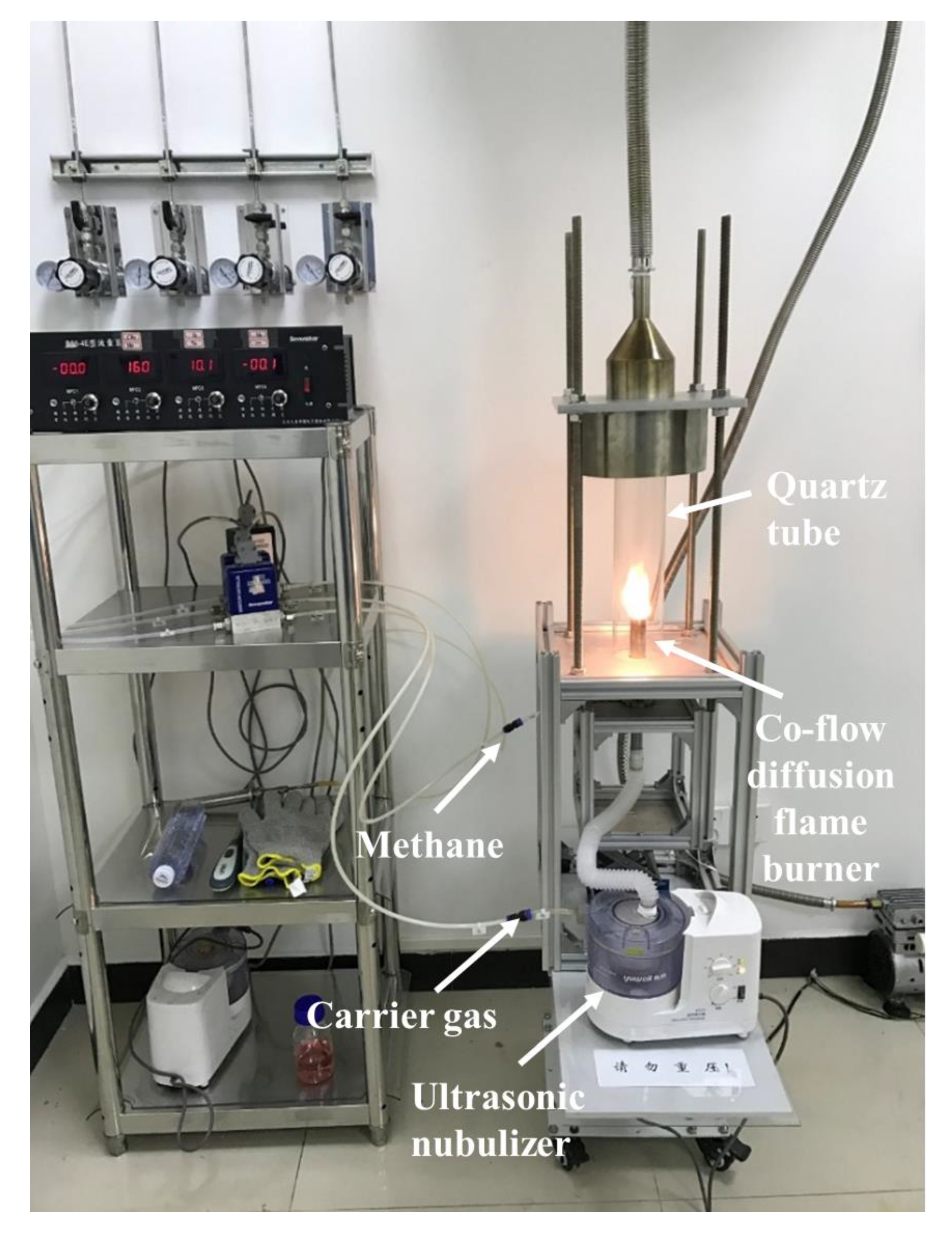
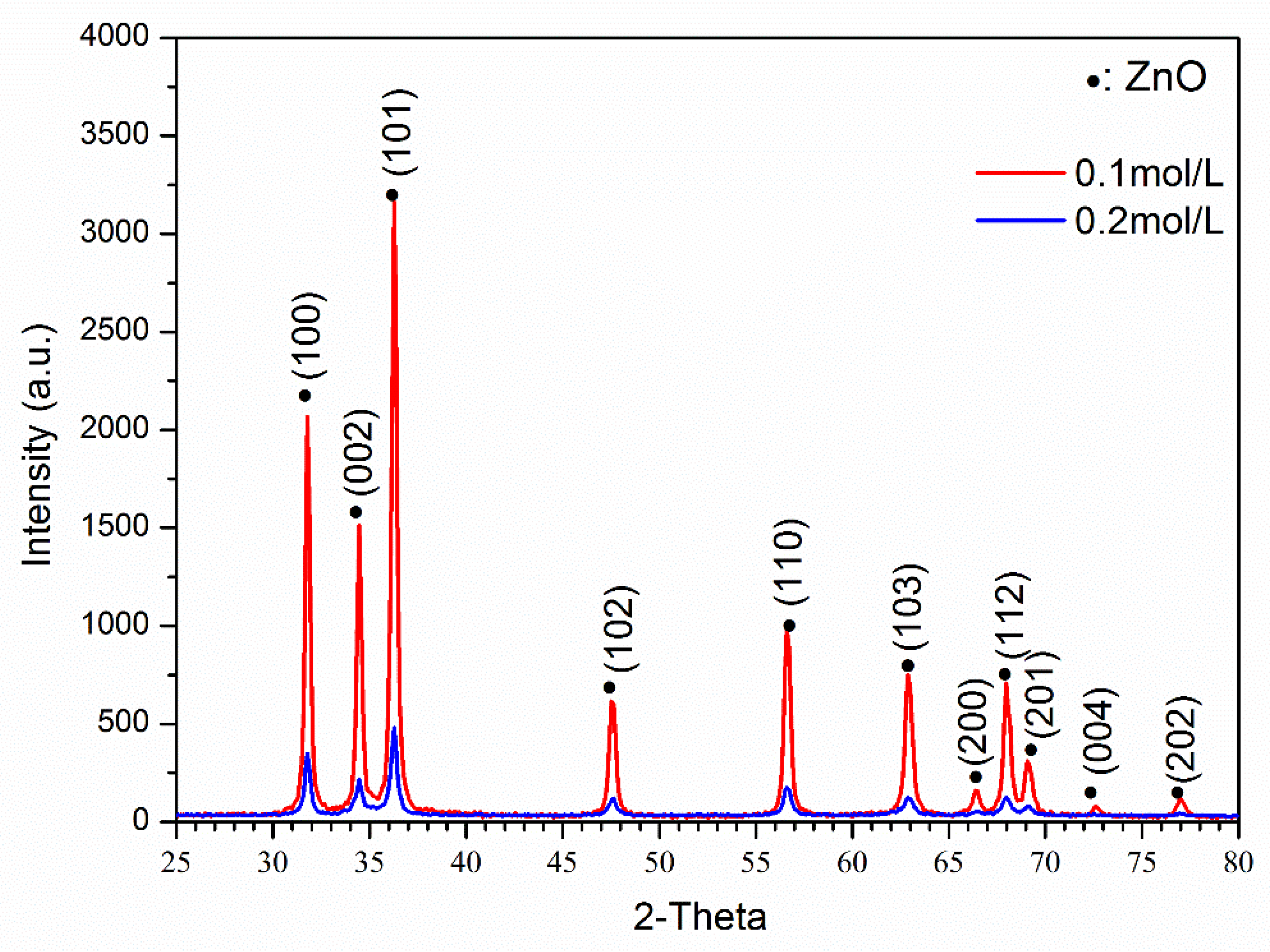
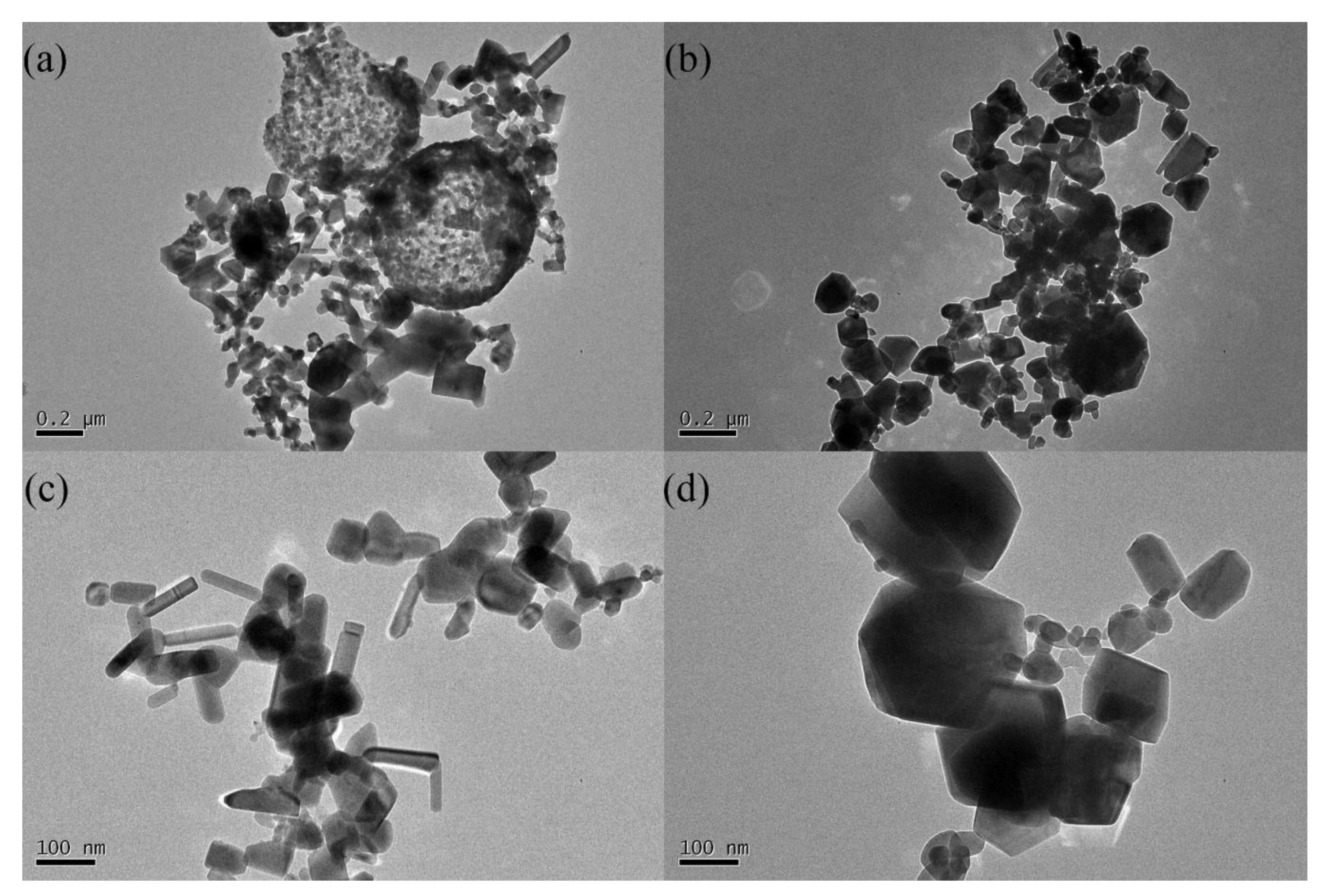
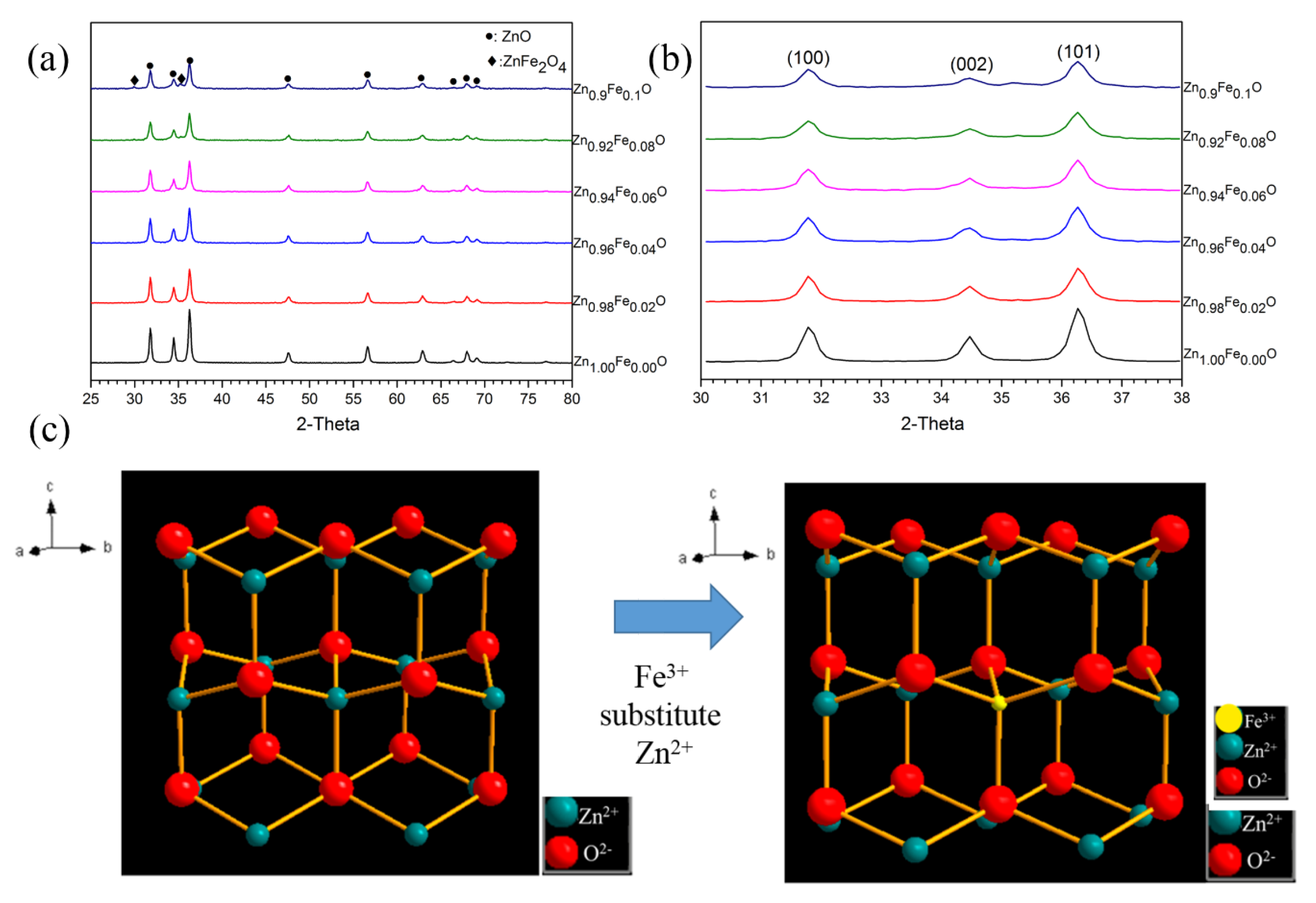

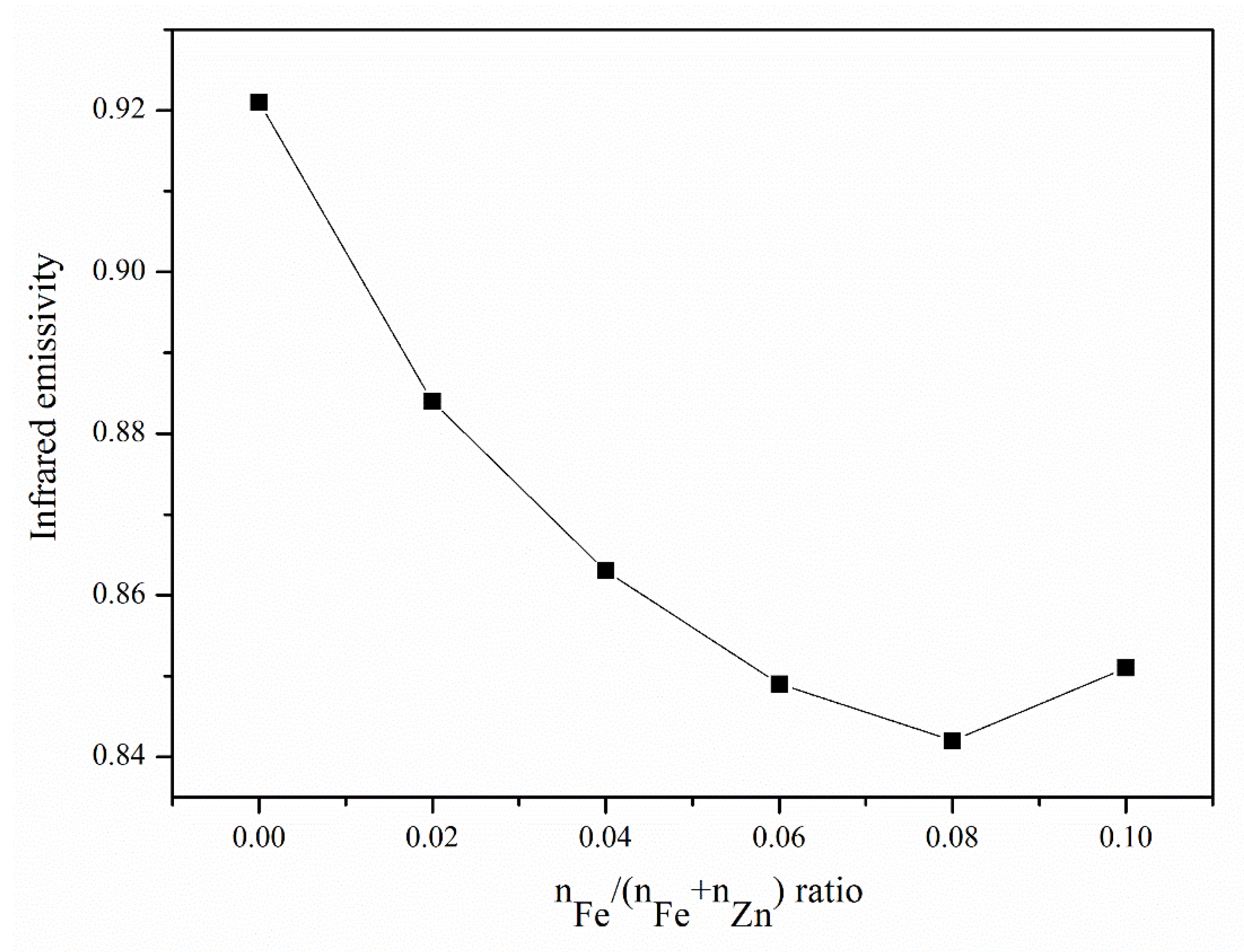
| Doping Amount of Fe | a-Axis Parameter (Å) | c-Axis Parameter (Å) | Grain Size (nm) | FWHM Values of the (101) |
|---|---|---|---|---|
| 0 | 3.2492 | 5.1956 | 45.8 | 0.26 |
| 0.02 | 3.2485 | 5.1943 | 46.7 | 0.25 |
| 0.04 | 3.2479 | 5.1928 | 43.5 | 0.26 |
| 0.06 | 3.2436 | 5.1843 | 49.5 | 0.27 |
| 0.08 | 3.2425 | 5.1823 | 46.9 | 0.28 |
| 0.1 | 3.2416 | 5.1806 | 42.2 | 0.31 |
| Method | Precursor | Synthesis Temperature and Time | Yield | Crystallinity | Particle Size |
|---|---|---|---|---|---|
| FAS | Zn(NO3)2•6H2O Fe(NO3)3•9H2O | Instantaneous high temperature | Vert high (kilograms per hour) | High | Tens nanometer |
| Coprecipitation [2] | Zn(NO3)2•6H2O Fe(NO3)3•9H2O CO(NH2)2 | 100 °C/1 h | Medium (grams per hour) | Low | Micrometer |
| Solid reaction [3] | ZnO, Co2O3 MnCO3 | 1250 °C/2 h | High (tens grams per hour) | High | N/A |
| Hydrothermal [4] | Zn(COOH)2 NaOH Ce(NO3)3•6H2O PEG20000 Cyclohexane | 140 °C/20 h | Low (milligrams per hour) | Medium | Sub-micrometer |
| Sol-Gel [5] | Zn(NO3)2 Citric acid Graphene | 80 °C/1 h | Medium (grams per hour) | Low | Tens nanometers |
Publisher’s Note: MDPI stays neutral with regard to jurisdictional claims in published maps and institutional affiliations. |
© 2021 by the authors. Licensee MDPI, Basel, Switzerland. This article is an open access article distributed under the terms and conditions of the Creative Commons Attribution (CC BY) license (https://creativecommons.org/licenses/by/4.0/).
Share and Cite
Tian, H.; Wang, L.; Yang, T.; Zhang, Z. Fabrication of Nanosize ZnO and Zn1−xFexO Powder for Infrared Absorption by Flame Aerosol Synthesis. Crystals 2021, 11, 904. https://doi.org/10.3390/cryst11080904
Tian H, Wang L, Yang T, Zhang Z. Fabrication of Nanosize ZnO and Zn1−xFexO Powder for Infrared Absorption by Flame Aerosol Synthesis. Crystals. 2021; 11(8):904. https://doi.org/10.3390/cryst11080904
Chicago/Turabian StyleTian, Hui, Lei Wang, Taisheng Yang, and Zili Zhang. 2021. "Fabrication of Nanosize ZnO and Zn1−xFexO Powder for Infrared Absorption by Flame Aerosol Synthesis" Crystals 11, no. 8: 904. https://doi.org/10.3390/cryst11080904
APA StyleTian, H., Wang, L., Yang, T., & Zhang, Z. (2021). Fabrication of Nanosize ZnO and Zn1−xFexO Powder for Infrared Absorption by Flame Aerosol Synthesis. Crystals, 11(8), 904. https://doi.org/10.3390/cryst11080904





